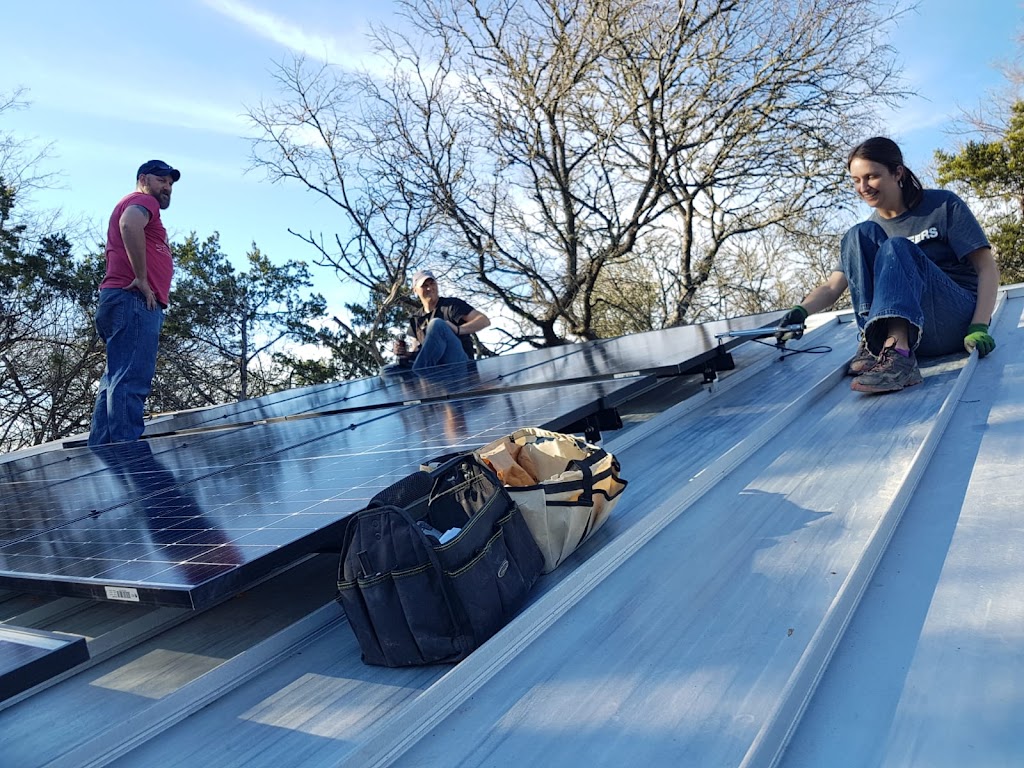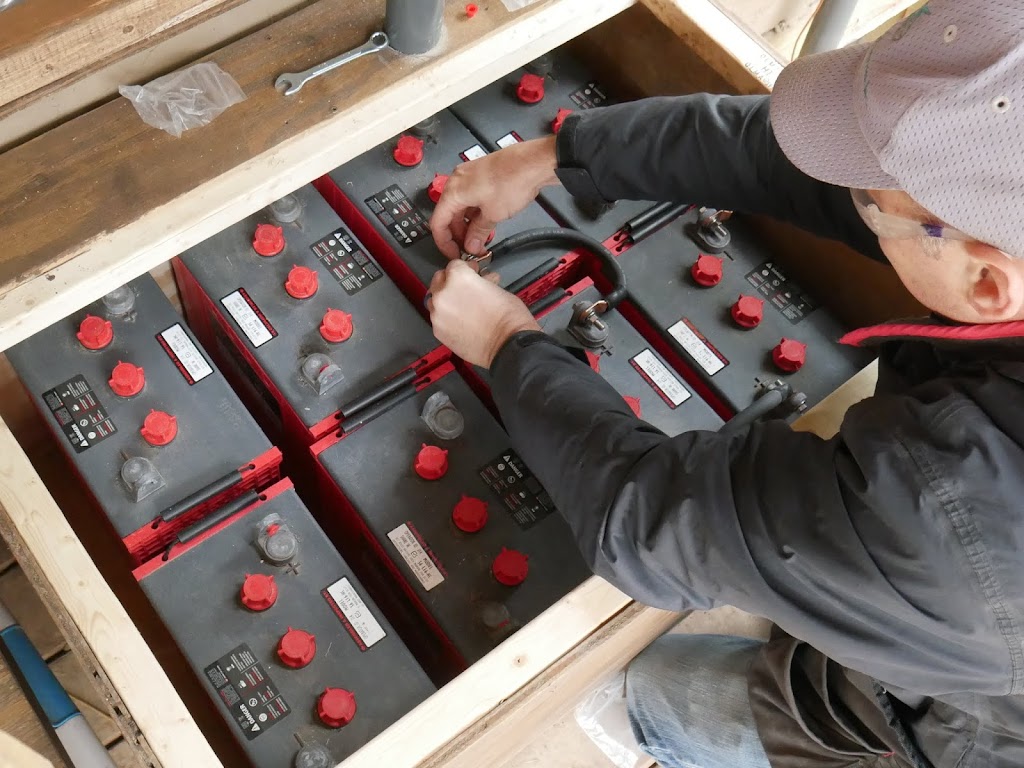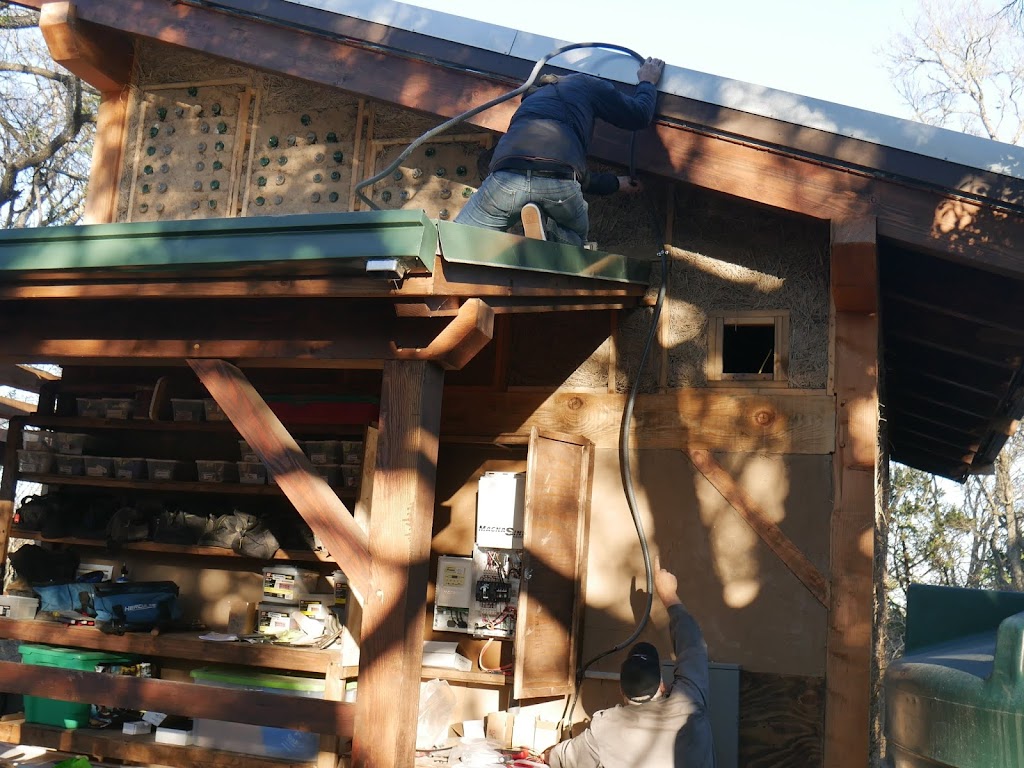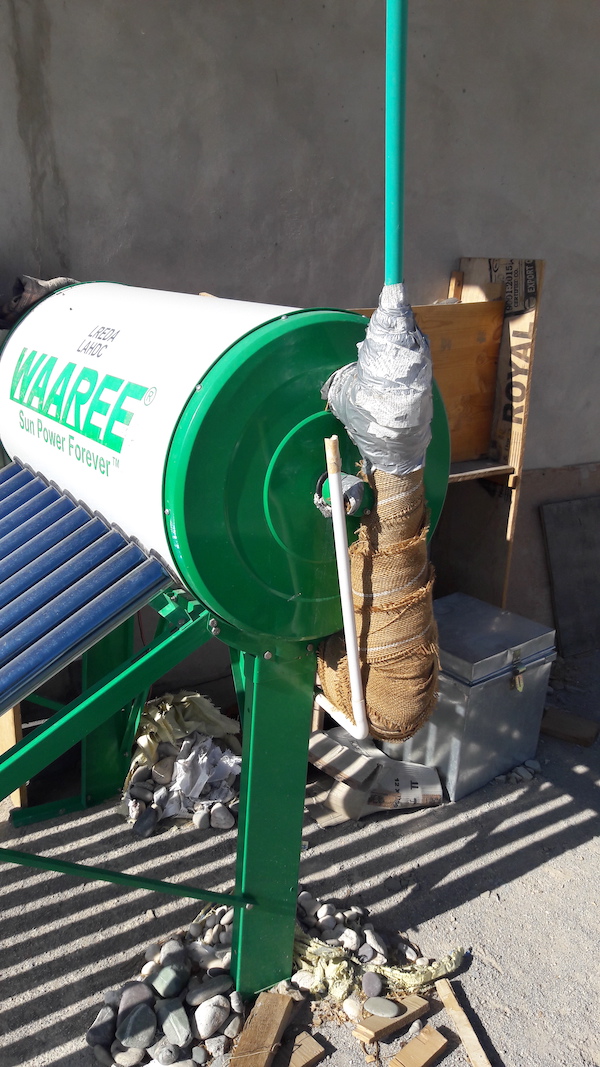
 10
10




 5
5







My suburban building and homesteading blog https://offgridburbia.com/
 2
2




David Baillie wrote:I searched but could not find a thread where people talked about their systems and their choices.
Installed 2013
Voltage: 48 volt system
Solar: 2x 3kw solar arrays
CHarge controllers: 2xOutback FM80
Inverter: 2x Schneider 6048SW conext Hybrid inverters paired
Batteries: Originally 32x L16 with 80KwHrs of storage
Currently 16xL16 with 40KwHrs of storage highly sulphated in need of replacement
 1
1




Michael Qulek wrote:
David Baillie wrote:I searched but could not find a thread where people talked about their systems and their choices.
Installed 2013
Voltage: 48 volt system
Solar: 2x 3kw solar arrays
CHarge controllers: 2xOutback FM80
Inverter: 2x Schneider 6048SW conext Hybrid inverters paired
Batteries: Originally 32x L16 with 80KwHrs of storage
Currently 16xL16 with 40KwHrs of storage highly sulphated in need of replacement
I'm surprised you haven't seen any of my previous posts? Just about the only thing I talk about here is off-grid solar.
I couldn't agree more that the root-cause of this failure is inadequate solar. I am ALWAYS admonishing people that the panels are so cheap these days that there is no reason whatsoever not to max input. I like to recommend that they use 1/8th of C as their target, and always to include a fudgefactor to correct for lower then spec solar output. I like to use 85%. Assuming those L-16 batteries are 400Ah each, and you have four strings of 48V, the math I would have used would be.....
(400Ah X 4 strings)/8 = 200A To get 200A out of the whole array that would be (200A X 50Vcharging)/85% = 11,765W. Just call that 12,000W and be done. As you can see, the previous installers only positioned 6,000W, about 1/2 of what I would have done.
 4
4




Iterations are fine, we don't have to be perfect
My 2nd Location:Florida HardinessZone:10 AHS:10 GDD:8500 Rainfall:2in/mth winter, 8in/mth summer, Soil:Sand pH8 Flat
 5
5




 2
2




thanks for posting Thomas; I love seeing what people have. If I had suitable water I would for sure do Hydro. That Midnite is probably loaded now. That's a decent array. How do you charge batteries with the Genny?Thomas Crow wrote:We're tiny.
1.72 kW solar
440 AH, 12v AGM battery bank
Midnite Classic controller
An inverter I don't care enough about to know who manufactured it because we only use it for the fridge.
Cheap-o generator who we run pretty hard for 3 weeks to a month in the middle of the rainy season but, hopefully, after we add a wind turbine and TEG this summer, will never be run again.
 1
1




 2
2




William Attenborough wrote:If you have 3 100watt panels connected in parallel in two strings can you connect these strings in series? I.e. parallel positive of one string to parallel negative to the other string creating a single series of two parallel arrays?
 1
1




hi William, if I understand correctly you have 3 panels total, two of them hooked up together in parallel and a single in a separate string... Is that correct? The 100 watt panels are probably feeding into a pwm charge controller at 12 volts? If those conditions are correct You could do it that way but I would usually do 3 strings of one panel each for balance.William Attenborough wrote:If you have 3 100watt panels connected in parallel in two strings can you connect these strings in series? I.e. parallel positive of one string to parallel negative to the other string creating a single series of two parallel arrays?
 1
1




 3
3





 2
2




Phil Stevens wrote:Grid-tied system. 4.4 kWp in 12 360W panels, half on a north-facing roof plane at 15 degree pitch, and the other half facing west at 45 degrees. This gives an elongated peak to the production curve, from noon to about 4 pm, and in the longest days of summer we're still generating at 8 pm. Enphase micro inverters with Envoy grid tie controller. We do net metering and the retailer pays us about 6.5c / kWh and charges 4-5 times that for what we use, so the other piece of the system is an interactive controller to sense whenever the panels are generating more than our aggregate load, and divert that excess to the hot water cylinder to create a thermal battery.
Here is what today looked like:

Good sun most of the time, with some cloudy periods shown by the dips. The blue is generation and the orange is consumption. The grey is import from/export to the grid of the excess in either direction and you can see how in the early afternoon the hot water reached its max (70 degrees) and at that point we started selling to the utility (boo). If the EV hadn't already been fully charged we would have plugged it in around 1 pm and taken advantage of all that juice.
Oh, and the system all up, including installation, was $14K NZ (~ $10K US) in October 2020. We financed it with our savings pool, so no interest.
 2
2




Ah... Well that would be a non standard way of doing it... You could do it but Your voltage would be lower and your amperage higher; somethings we try to avoid. You also would not get the full benefit of your mppt charge controller. In your case I would create 2 strings of 3 panels each. each string would be wired positive to negative for roughly 57-58volts each string at 6.26 amps. you then combine those two parallel strings to form one feed of 57-58 volts at 12.52 amps. You are still well within the voltage levels of the epever and are putting in less amps more volts so you get less voltage loss and a thinner wire...William Attenborough wrote:Hi David, thanks for getting back to me. I should clarify my original statement. If you have 6 100w panels (19.23v 6.26amp each panel). You wire string #1 with 3 panels in parallel and string #2 with 3 panels in parallel, can you then connect these two strings into a Series by connecting the positive of string #1 to the negative of string #2? So it would be 2P1S, Is this safe? Would this wiring configuration provide 38v± @ 19± amps? All of this feeds an Epever 1050watt 100v 40amp MPPT in 24v configuration. This feeds (12) 220amp 6v Flooded GC2's wired in 24v series-parallel.








William Attenborough wrote:Thanks David. Thank you for your patience and help.







 1
1




 1
1




Phil Stevens wrote:Battery storage is very much on the horizon as soon as we have the bulk of the cost paid back, David. I tend to lean toward the long-lived and abuse-tolerant forms of storage that don't require scarce elements to manufacture, so Ni-Fe has always held an attraction. So have flow batteries. We'll see.
The diverter is made by Paladin: http://www.paladin.nz/ and can be used with any intensive load, including EV charging.
 3
3








Neil Bendy wrote:It's been ongoing for a couple of years now starting with 2*100W panels and a few 6V golf cart batteries as an experiment.
Now it's 24 used 250watt panels on my south facing roof, which fortunately is at the perfect summer/winter compromise angle, giving me a theoretical 6Kw, but in reality I've never seen more than 4kw.
Feeds into two MPP all in one 48V units linked in series, then into my 6 DIY LiFePo4 banks, 4 with 16*200A cells and 2 with 16*280A cells, so about 55Kwh capacity, all with the associated fuses, breakers and BMS units.
Been powering the house, including 2 mini split A/C heat pumps, and so far very few problems.
It's been overcast and cold today and even with both heatpumps running flat out the batteries are all around 90% - 95% full at 2PM.
I knew it was uneconomic when I began so it's more of a hobby than anything else, but so far, it works and it's been fun, especially when you hit an 11 on the smug scale when mine is the only house with power during one of the regular outages around here.




 2
2




 I also have a separate system of solar hot water, since my hot water was oil heated when I bought the house. That I've had since 2011. I love that it has an 80 gallon tank so that when the sun is heating the water, it heats the whole tank, but in the winter when the panels are covered with snow, there is electric backup that heats only the top 30 gallons.
I also have a separate system of solar hot water, since my hot water was oil heated when I bought the house. That I've had since 2011. I love that it has an 80 gallon tank so that when the sun is heating the water, it heats the whole tank, but in the winter when the panels are covered with snow, there is electric backup that heats only the top 30 gallons.  1
1








yes and no. Car ones especially won't last long. Car batteries have many very thin lead plates in them so they can give off the maximum amounts of amperage for a very short time for starting and usually don't ever get discharged since the alternator immediately boosts them back up. Deep cycle batteries are designed with thicker plates to take the stress of heavy charging and discharging. The "marine deep cycle" can be a good starter solar battery as it's a compromise between the two.Dee Jacobs wrote:I have a question for you guys and gals.
Can you use car or boat batteries for energy storage?
 1
1




Making my world a better place, one permaculture decision at a time.
 2
2




Trying to step off the wheel, so I can get from behind the wheel.
 1
1




Mary Haasch wrote:I'm living in a small cottage with a 50 yo in the wall electric furnace (not used much until the last 2 years) and I'd like to add solar electric. I've preliminarily spoken to two different companies, not sure what I think of either one, but both think putting panels on the roof is cheaper than putting panels on the ground in the open area. The cottage roof panels would require new roofing which has about 5 - 7 years of expected life and cutting down the trees which have grown up close to the building. While both things would need to be done eventually, the open area installation seems more immediately cost and effort effective. In addition, the ground-based system in the open area could be used to power the workshop, the garden shed and the eventual small barn planned for the open area (the workshop and garden shed are existing). Any words of wisdom?
 1
1




 1
1




Sandra Gill wrote:I do not have solar panels but I have a question how does one clean the grime off the panels? When one looks at them the should appear from the side to be coated in brown dirt coating not shiny and dark. I have even seem this build up on huge panels on businesses. We have not had heavy rains lately just one which creates a damp surface them the wind shifts and dust and pollen are added on the previous stuff. So much power is being lost due to grime. I would think Dawn dishwashing the one used in a sink blue formula would be best since it claims to be safe for the environment. I wonder is the power hose cleaner would be good as well. I do wonder about how they the panels are redesigned to be in the weather.
 2
2




 1
1




Dee Jacobs wrote:I have a question for you guys and gals.
Can you use car or boat batteries for energy storage?
 1
1




Mary Haasch wrote:... the open area installation seems more immediately cost and effort effective. In addition, the ground-based system in the open area could be used to power the workshop, the garden shed and the eventual small barn planned for the open area (the workshop and garden shed are existing). Any words of wisdom?




David Baillie wrote:
Mary Haasch wrote:I'm living in a small cottage with a 50 yo in the wall electric furnace (not used much until the last 2 years) and I'd like to add solar electric. I've preliminarily spoken to two different companies, not sure what I think of either one, but both think putting panels on the roof is cheaper than putting panels on the ground in the open area. The cottage roof panels would require new roofing which has about 5 - 7 years of expected life and cutting down the trees which have grown up close to the building. While both things would need to be done eventually, the open area installation seems more immediately cost and effort effective. In addition, the ground-based system in the open area could be used to power the workshop, the garden shed and the eventual small barn planned for the open area (the workshop and garden shed are existing). Any words of wisdom?
Hi Mary, Stay on the ground. Between added costs of rapid shutdown, engineering and city permits the costs of roof mount add up. Now maybe your area does not have any of that if so then maybe but clearing and new roofing is a cost as well. Ground mounts can be perfectly aimed at the sun and if you choose the right racks can be adjusted with the seasons for best gain and if snow is an issue easily cleared. I have to say heating and solar electric don't usually work well together unless you do a net metered connection to the grid. Is that the plan? Usually when you need heat the days are shorter and there is less solar potential so without the grid to balance out the seasons it's challenging. A good choice might be switching out that electric resistance wall furnace for a mini split heat pump which will use one third the electricity for the same amount of heat
Cheers, David Baillie
Making my world a better place, one permaculture decision at a time.
 1
1




Mary Haasch wrote:
David Baillie wrote:
Mary Haasch wrote:I'm living in a small cottage with a 50 yo in the wall electric furnace (not used much until the last 2 years) and I'd like to add solar electric. I've preliminarily spoken to two different companies, not sure what I think of either one, but both think putting panels on the roof is cheaper than putting panels on the ground in the open area. The cottage roof panels would require new roofing which has about 5 - 7 years of expected life and cutting down the trees which have grown up close to the building. While both things would need to be done eventually, the open area installation seems more immediately cost and effort effective. In addition, the ground-based system in the open area could be used to power the workshop, the garden shed and the eventual small barn planned for the open area (the workshop and garden shed are existing). Any words of wisdom?
Hi Mary, Stay on the ground. Between added costs of rapid shutdown, engineering and city permits the costs of roof mount add up. Now maybe your area does not have any of that if so then maybe but clearing and new roofing is a cost as well. Ground mounts can be perfectly aimed at the sun and if you choose the right racks can be adjusted with the seasons for best gain and if snow is an issue easily cleared. I have to say heating and solar electric don't usually work well together unless you do a net metered connection to the grid. Is that the plan? Usually when you need heat the days are shorter and there is less solar potential so without the grid to balance out the seasons it's challenging. A good choice might be switching out that electric resistance wall furnace for a mini split heat pump which will use one third the electricity for the same amount of heat
Cheers, David Baillie
Thank you so much for those words of wisdom. Now I know what I should insist on and I hadn't thought about aiming for the seasons although I did think about clearing the snow and there's plenty of it. I'm not trying to go off grid completely, at least not yet, since I work from home so this would be a supplemental power source and perhaps a backup when the grid lets me down. I know that the electric furnace isn't going to last forever so I very much appreciate the suggestion for a mini split heat pump. Lots to consider. Has anyone heard if there are incentive programs for the companies that only happen with a roof installation?
 6
6




Lif Strand
New Mexico USA
 2
2








sounds like a lot of fun Tom! Have you thought of retiring the C40 rewiring the panels for a higher voltage and put in a new mppt... You would probably gain 20 percent extra production from that array especially in the winter and grey days.The Magnum is a great reliable inverter.Tom Moran wrote:There are all kinds of ways of doing solar just like anything. We were fortunate to have bought a straw bale off grid home in mid Missouri. It has a 1kw array about 20 years old ($6 a watt then!) to which I’ve replaced batteries ( most expensive part)twice: first with Trojan L16s now with big Trojan Ind6 industrial batteries. We’re run an old trace c-40 controller with a newer magnum pae 4024.
Since then we added a second system using 12 newer us solar 235 watt panels on our barn roof ( note to self: don’t do that again- too hard to get snow off them). 4 sets of three panels. Wire runs 120’ underground to midnight solar 150 classic sl thence to the old trace 24 v inverter and 4 rolls surrette 300 pounders.
I did all the work on second system myself using best deals I could find to keep costs down.
You can do it for less yourself if you’re conscious of $ and safety. Good luck.
Try solarbiz. They did me right on the batteries!




Roy Therrien wrote:We installed our 9.6 kW system just a few months ago. It's grid-tied and totally self-running.
We monitor it quite closely with its truly outstanding Solar Edge interface.
We also upgraded our roof to metal, making everything easier and cleaner (esp. rainwater harvest).
• 26 Silfab 370-watt PV modules
• SolarEdge 7.6kW Energy Hub inverter
• LG RESU16H Prime 16 kWh Li-ion battery
When grid power goes down, the system kicks in near-seamlessly. The momentary glitch whacks the microwave clock, so when we wake up and it is flashing, we know the power went out. Otherwise, we wouldn't even know!
The stove and hot water heater are about the only things not on the solar back-up panel. We heat exclusively with wood.
You can see from the last photo, we're in a prime situation to add a sun-room on the south side of our home. We're making zero use of passive solar as-is. We just bought the home 1.5 years ago and it's 35 years old, so lotsa updates/upgrades to do. That new (timber-framed!) sunroom roof will get lined with another 10+ panels, a relatively easy investment/upgrade given all the other infrastructure is already in place.
Now it's all done though, truth be told, I don't like it (this solar PV system). Too expensive, too complex, too limiting, too vulnerable. Too many-other-things. I personally think there are a large number of other better ways to manage electricity/energy production and consumption, all of which are well covered here on Permies. First and foremost, use less!




Making my world a better place, one permaculture decision at a time.

 3
3





Works at a residential alternative high school in the Himalayas SECMOL.org . "Back home" is Cape Cod, E Coast USA.

|
Cats say "meow" because they think that is what people sound like. This tiny ad told me so:
Freaky Cheap Heat - 2 hour movie - HD streaming
https://permies.com/wiki/238453/Freaky-Cheap-Heat-hour-movie
|





